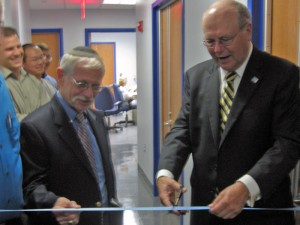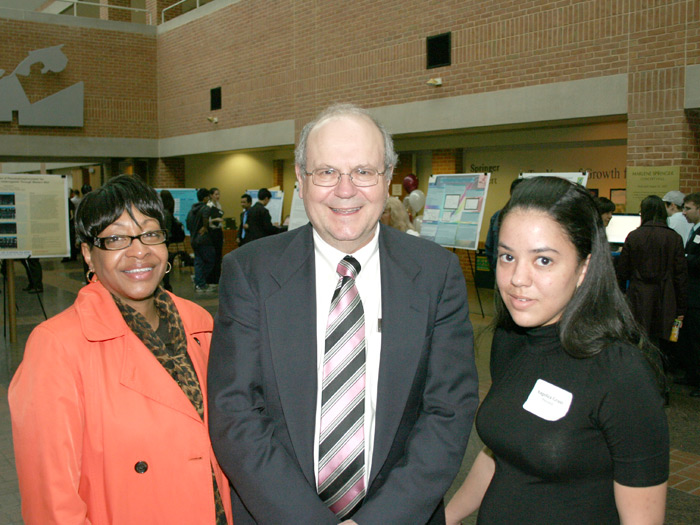
Facility Director Dr. William L'Amoreaux (rear) and Facility Manager Dr. Michael Bucaro discuss the structure of a single cell captured using a confocal microscope.
After eight months of renovation and expansion, the College of Staten Island’s Advanced Imaging Facility (AIF) reopened recently with a ribbon-cutting ceremony that included CSI Interim President Dr. William J. Fritz, Interim Provost and Senior Vice President for Academic Affairs Dr. Fred Naider, and Dean of Science and Technology Dr. Alex Chigogidze. AIF Director and Professor of Biology Dr. William L’Amoreaux also conducted a tour of the facility for the assembled faculty and students.
The upgrades to the AIF, which included a nearly doubling of the floor space and increased the number of rooms in the suite from six to 13, showcases the over $3 million in equipment housed in the facility. Included in the inventory are an X-ray microanalysis system to identify which elements are present in samples, and a confocal microscope to provide detail into subcellular structures. These instruments were funded through two National Science Foundation grants in the amounts of $227,000 and $480,000.
Before he cut the ribbon to open the AIF, Dr. Fritz commented that the facility “is one of signature parts of the campus. We have lots of gems on campus, but certainly, the Imaging Facility ranks right up there at the top.”
Dr. Naider stated, in his remarks, that “there are so many fields today in science that are dependent on imaging. They go from structural biology to cell biology to material science to nanoscience…I think what’s exciting is that I look around this room and see biologists, biochemists, polymer chemists, people who are all doing different types of science who are going the benefit from having this particular facility.”
According to Dr. L’Amoreaux, “The facility, which is a core facility for faculty at CSI, is available for use by investigators from all CUNY and non-CUNY campuses. It houses a transmission and a scanning electron microscope, the confocal laser scanning microscope, an atomic force microscope, a live-cell imager, flow cytometer, fluorescence-activated cell sorter, and a host of ancillary equipment for specimen preparation.”
As far as the applications and reach of the AIF are concerned, Dr. L’Amoreaux explained that it “provides high-resolution imaging equipment for the analysis and characterization of specimens. These specimens range from nanostructured materials to complex polymers to biological cells and tissues. These resources are available to all CSI faculty, and their graduate students and post-doctoral students. What makes the CSI AIF unique is that students in high school and undergraduates may use equipment that are either unavailable to them as undergraduates (they must wait until graduate school) or not available at all.”
The AIF is also unique, according to Dr. L’Amoreaux, because it is “a core facility that houses all the instruments, and under one director. At other colleges, they may have a transmission electron microscope in Biology, and scanning electron microscope in Geology, and atomic force microscope in Physics, but we have had the foresight to house these together. City College of New York’s new Advanced Science Research Center will adopt this to some extent, but will have different managers for different equipment.”
Looking to the future of the AIF, Dr. L’Amoreaux not only emphasizes the impact that it will have on research, but on education on the Island. “The future plans for the facility are to provide our world-class faculty with the tools needed to further their research, but also to use this as a recruiting tool to retain Staten Island’s best high school students. To this day…I am still amazed at the number of students from Staten Island that matriculated at either a SUNY or even another CUNY campus who have come out to take a course only to find that the resources that they were looking for in the pursuit of a degree were closer to home than expected.”


















